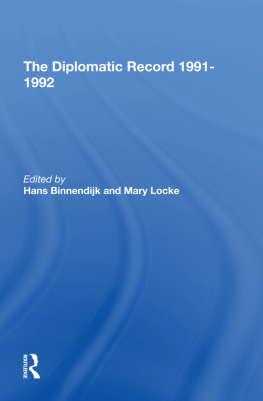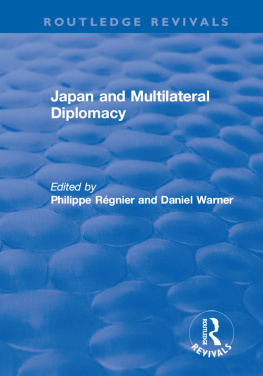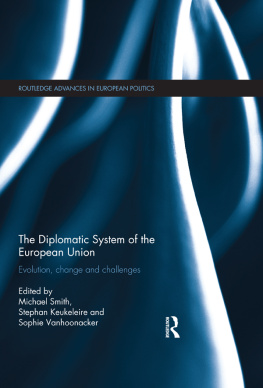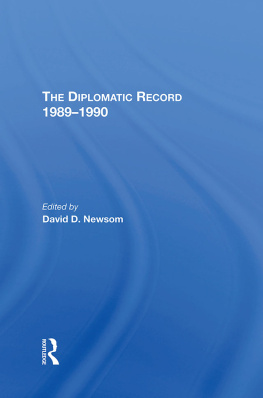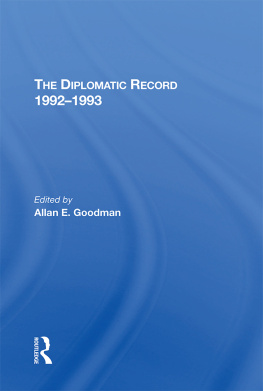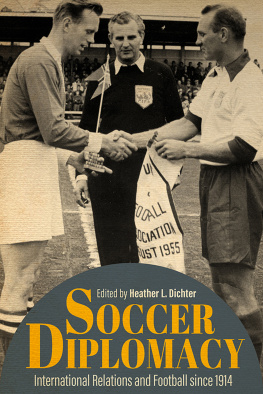First published 1993 by Westview Press
Published 2019 by Routledge
52 Vanderbilt Avenue, New York, NY 10017
2 Park Square, Milton Park, Abingdon, Oxon OX14 4RN
Routledge is an imprint of the Taylor & Francis Group, an informa business
Copyright 1993 Taylor & Francis
All rights reserved. No part of this book may be reprinted or reproduced or utilised in any form or by any electronic, mechanical, or other means, now known or hereafter invented, including photocopying and recording, or in any information storage or retrieval system, without permission in writing from the publishers.
Notice:
Product or corporate names may be trademarks or registered trademarks, and are used only for identification and explanation without intent to infringe.
Library of Congress ISSN: 1052-0309
ISBN 13: 978-0-367-29132-7 (hbk)
In diplomacy, as in good driving, periodic glances in the rearview mirror are recommended. Seeing where you have been gives you a better sense of where you are. It is also useful to have early warning of the occasional fast-moving vehicle rapidly approaching from behind.
No matter what our readers occupationpractitioner, scholar, journalist, or student of international affairsthis third volume of The Diplomatic Record is the recommended look in the rearview mirror. It gives a panoramic glimpse of territory just covered. Theories describing what the post-Cold War world will look like are useful, but it will take several years to prove their validity. This volume reveals to readers the impact of recent events on diplomacy a year or so into the post-Cold War world.
As in past volumes, this collection of essays concentrates on diplomatic negotiations, the process that, with skill and luck, can prevent wars or settle them quickly after fighting begins. Negotiations can involve economic, scientific, and other nonsecurity issues as well as efforts to regulate international behavior and avoid escalation of disagreements into security problems. But this volume differs from its predecessors in that the impact of the end of the Cold War has profoundly affected the nature and course of every negotiation considered by our authors.
The essays are divided into five broad topicsdisintegration in the East, integration in the West, new relations with old allies, changes in the Third World, and multilateral diplomacy. and the section entitled Looking Ahead offer, among other things, a look at the United Nations and other international mechanisms for dealing with problems in an increasingly multilateral world.
In the first essay, William Green Miller goes to the source of change: the disintegration of the Soviet Union. He describes a cautious, uncertain, and reactive US policy working on two tracks, struggling to maintain good relations with both Mikhail Gorbachev and Boris Yeltsin as they battled for power. Miller tells in vivid detail how the United States leaned first toward Gorbachev and stuck with him officially during most of 1991, but about mid-year began to pay more attention to Yeltsin as his boldness, courage, and parliamentary skills became increasingly evident.
Next, Ivo H. Daalder describes a dramatic shift of means and goals in American nuclear diplomacy. In July 1991, the United States and the USSR signed the Strategic Arms Reduction Talks (START) agreement, culminating a decade of laborious negotiation. After the August coup attempt in the USSR, priorities changed to enhancing secure command and control over Soviet nuclear forces, preventing instant nuclear proliferation, eliminating ground-based tactical nuclear weapons, and seeking deeper reductions in strategic nuclear warheads. Because negotiators needed to keep pace with the radical political changes described by Miller, they shed formality and effective verification in favor of reciprocal unilateral pronouncements. From the signing of a START protocol that will concentrate all nuclear weapons in Russia by 2000 to the massive strategic nuclear reductions announced at the Yeltsin-Bush summit in June 1992, US diplomacy successfully took advantage of opportunities created by Soviet disintegration.
, John Zametica argues that the EC representatives started too late, dealt initially with the wrong leaders, were unable to narrow their differing views on local sovereignty until late in the negotiations, and used ineffective economic sanctions as their primary tool. The best efforts of Lord Carrington and his colleagues may have been doomed from the outset because most of the parties in Yugoslavia stood to benefit from conflict and the EC was unable to raise the stakes by threatening massive peace-enforcement operations.
As nations east of the former Iron Curtain disintegrate, the most pronounced phenomenon west of that line is union. In , Alan K. Henrikson describes trilateral negotiations to create a North American Free Trade Agreement (NAFTA). The United States has supported the concept of an economic zone from the Yukon to the Yucatan to strengthen its political and economic posture in the world. After dealing with labor, environmental, and human rights interest groups that oppose the effort, the US Congress gave President Bush fast track authority for the negotiations. The negotiations concluded in August and the congressional review will be completed in 1993.
Whereas a NAFTA would create a loose economic association, the European Community embarked on a much more ambitious plan for economic, monetary, and political union. In , Jenonne Walker provides keen insights into the give-and-take that culminated in the December 1991 Maastricht summit agreement. She describes bold US tactics to influence the results and concludes that although the United States and Britain may have gained some concessions on security issues, the final text closely tracks French and German positions.

